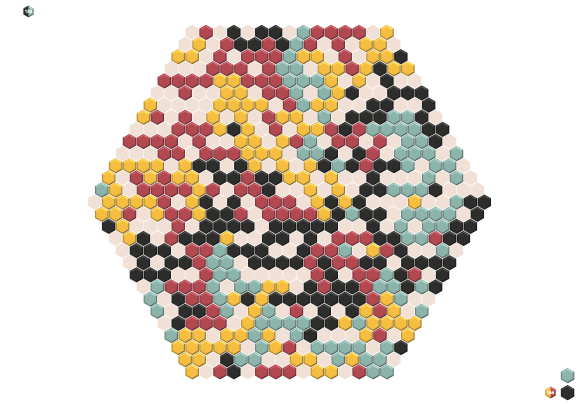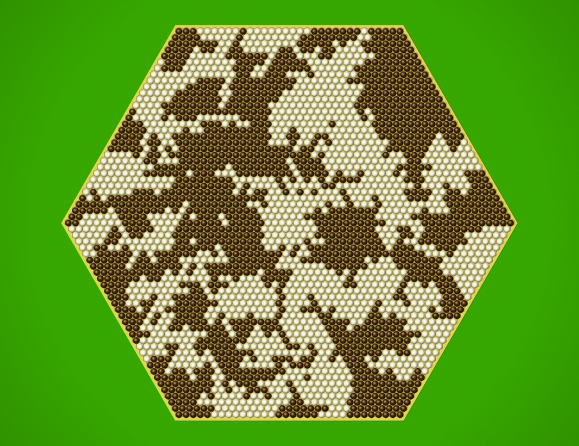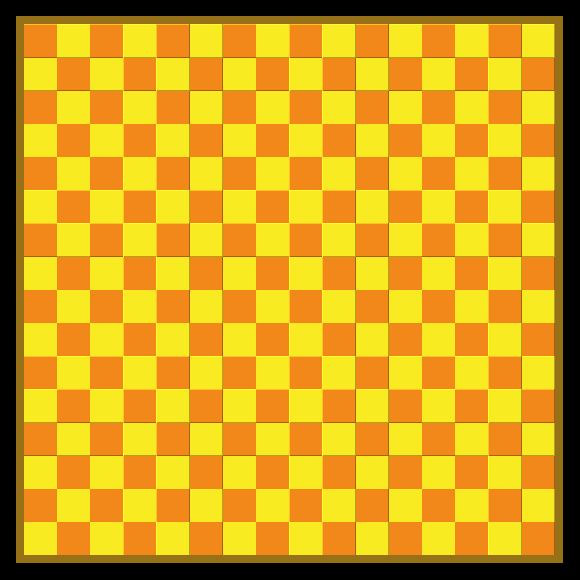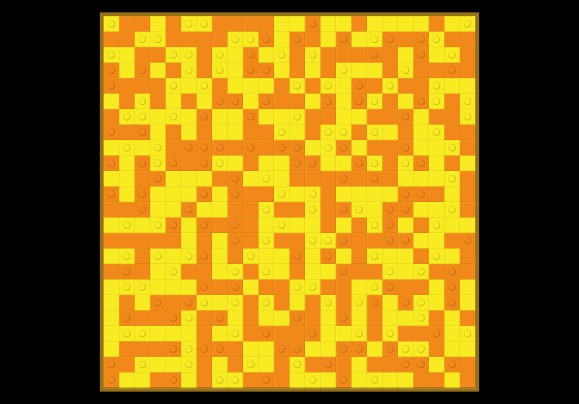Since my first post on my game Permute, there’s been a very exciting development. Thanks to the efforts of Stephen Tavener — thank you, Stephen! — Permute is now playable in his wonderful abstract-gaming mega-package Ai Ai!
Ai Ai is a fantastic, and free, collection of many dozens of excellent abstract games, all playable online or against various strong AI opponents. I’ve talked about it in my Connection Games series a few times, but I can’t emphasise enough how essential it is if you have any interest in this category of games at all. Ai Ai includes everything from classics like Go, Chess and Draughts, to modern legends like Amazons, Havannah, Symple, and Catchup.
Ai Ai is particularly great if you like to experiment with games. The platform is incredibly robust, and with some simple modifications to the MGL files that define the parameters of each included game, you can try out ludicrous variants of your favourite games and Ai Ai takes it all in stride. As you can see in my post on Symple, you can play games on ludicrously large boards if you like, or modify starting positions, and so on.
- A game of Blooms on hexhex-15? Sure, why not?
- HexSymple on hexhex-32? Let’s do it.
Even better, Ai Ai is festooned with super-interesting analysis functions that you can use to investigate all the included games. You can generate opening books and endgame puzzles, produce detailed statistics on game complexity, create detailed reports on branching factors throughout a typical game, and much, much more. I used Ai Ai to generate a full report on Permute, which Stephen has uploaded to the Ai Ai website here.
A big part of the reason I was so excited to have Permute in Ai Ai is because of these analysis functions. While my initial testing of Permute showed that the game is fun and allows interesting strategies to develop, there were a couple of lingering questions:
- Draws are theoretically possible on the recommended even-length board sizes (12×12 and 16×16). How likely are draws in typical play? Is it possible that high-level Permute play could become infested with draws?
- Permute does not use a balancing protocol like the swap rule we use in many other games like Hex or Havannah. Is the game balanced enough as-is, or does the first or second player have an advantage? Should I add a balancing protocol?
- Is it possible that symmetric playing strategies might break the game?
The Ai Ai report helped alleviate my concerns on these three aspects. While of course these results shouldn’t be taken as gospel, I’m comforted by the fact that in 88,891 games played by the AI, not a single one was drawn! On top of that, the winning chances for each side across all those games was 49.99% for Orange and 50.01% for Yellow — nearly perfectly balanced. Finally, Ai Ai attempted to win with various mirroring strategies, but lost every game in those instances. Permute might still prove to have issues on these fronts when attacked with superhuman neural-net AI, or super-strong humans, but at least I can rest assured that the game doesn’t break too easily.
Playing Permute in Ai Ai
When you load up Ai Ai, you can find Permute in the ‘Combinatorial 2020’ category, which you can find in a folder if you go to the File menu and click ‘Choose Game…’. Once it loads up you’ll be presented with a dialog box to choose a few options:
- Resign when hopeless? This means that the AI will determine when it has no chance to win, and will resign at that point rather than playing on. This is a very convenient feature, though for new players it might be worth playing a few games without it on, so that you see games all the way through to the finish.
- Alternate setup? This allows you to choose the alternate starting position with a 2×1 chequerboard pattern rather than the standard chequerboard.
- Board size: Here you can choose the size of the board, ranging from 8×8 to 24×24. The default is 12×12, which is a good size to start playing on. When you want a deeper, longer game, I’d go for 16×16.
After choosing your options, you’ll see something like this:

Here I’ve loaded up a 16×16 game with the standard chequerboard setup. If this is your first time starting Ai Ai, you may find the default will be for you, the human player, to play as Orange and the AI to play as Yellow, but you can change this to Human vs Human or AI vs Human or AI vs AI using the AI menu.
Stephen has implemented a very handy system for making moves in Ai Ai that uses mouse-dragging to determine which direction your twists will go. To make a clockwise twist, locate the 2×2 face you want to twist, and click and drag from the top-left of that face to the bottom-right; to make a counterclockwise twist, drag from the bottom-right to the top-left. After that, just click on one of your just-twisted pieces to bandage it, and there you go — your first Permute move! If at any time you need a reminder of how the moves work, just click the Rules tab on the right side of your Ai Ai window.
Once you get used to the input method you’ll find Ai Ai is an incredibly convenient and flexible way to play the game. By changing the AI thinking time in the AI menu, you can tailor your opponent to your skill level. Beware, Ai Ai can be very strong if you give it lots of time! To give you an idea of what Ai Ai plays like on higher thinking times, here’s a sample AI vs AI game played with ten seconds of thinking time per move:
- The complete game (90 turns in total) in animated GIF form.
- The final position. Orange won, 27 to 25, but it was a close one!
This game was quite a good one, a close back-and-forth battle. As is typical from the AI, the game was fought initially in the corners, and once territories took shape there, both sides extended into the centre to battle for dominance there. This seems a good way to open a game of Permute in general — territory is easier to secure along the corners and edges with fewer bandaged pieces required, and once some gains have been made in those areas the protected groups can be used as a base to stake a claim on the centre of the board.
Just for kicks, here’s another sample game played on a 24×24 board, this time with 5 seconds of thinking time per move:
- The complete game in animated GIF form; this battle lasted 213 turns.
- The final position. Orange takes this one with a comfortable 10-stone margin, 42 to 32.
As readers of this blog will know, I generally love playing abstract games on larger boards anyway, but I particularly love playing Permute on big boards. There’s something extremely satisfying about seeing these huge chequerboard patterns gradually coalescing into interestingly-shaped blocks of colour. On the larger boards there are tantalising hints of fascinating strategies lurking in the distance; as you’ll see in the game above, the AI battled itself across the whole board, and intriguing local battles eventually linked together into larger contests as the game evolved. Playing on a physical board this size might be a bit challenging, not just in terms of space but also in terms of keeping track of group sizes, but since Ai Ai takes care of both those problems, I highly recommend trying some bigger boards when you have time! In truth 16×16 will stay my recommendation for tournament play, but I can say for sure that 20×20 and 24×24 have real potential, and the resulting games still take less turns than a game of 19×19 Go to play out, given that each move affects a decent-sized chunk of the board.
What’s next?
I hope the info above might convince you to give Permute a try using Ai Ai. This program is essential for any fan of strategic games regardless, and the implementation of Permute is just perfect. The AI plays a tough game, and you can easily experiment with larger board sizes and the alternate start position. As you can probably tell, I’m hugely excited to have Permute available on Ai Ai, and I’m enormously thankful to Stephen Tavener for taking the time to implement it!
Hopefully this won’t be the end of exciting news for Permute. I’ve been speaking with some very talented designers about the game, and earlier today I received a beautiful concept for a purpose-built physical game set for Permute that just blew me away. Abstract games are a bit of a risk for publishers compared to more accessible, flashier board games with fancy bits, but nonetheless I do intend to keep investigating if this game could be realisable physically. In the worst-case scenario, perhaps we could offer 3D-printed game sets for fans to purchase, if publishers don’t want to take a chance on it.
In any case, I hope you’ll download Ai Ai and give Permute a shot! Let me know how you get on with it. Keep an eye on these pages for more updates on the game, and hopefully some strategic tips and tricks as I gradually become less awful at it 🙂






